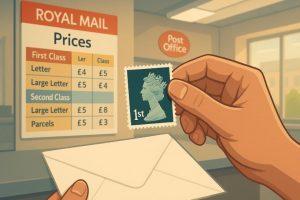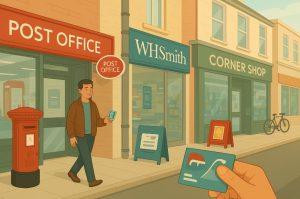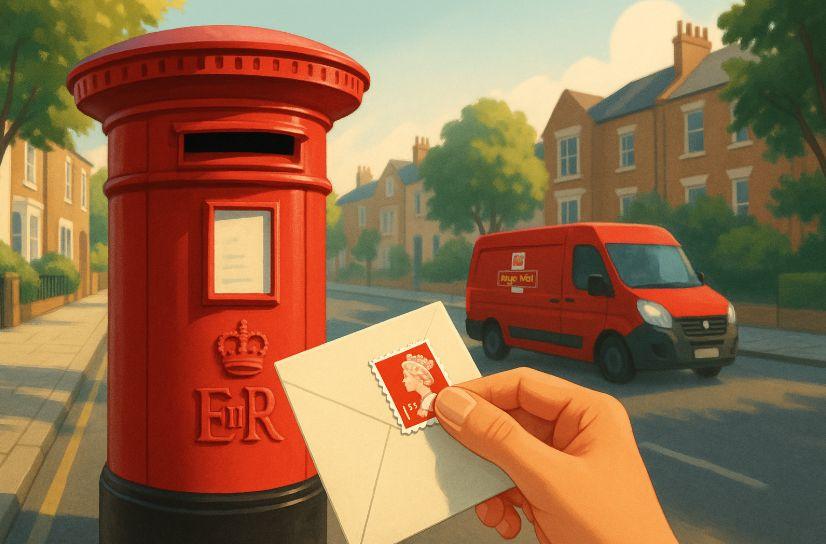In an increasingly digital world, the humble postage stamp continues to play a vital role in communication, particularly for businesses and individuals who rely on the reliability and speed of Royal Mail.
As of 2025, the first class stamps cost in the UK has seen a noticeable change, sparking interest among regular senders and occasional users alike. With updated pricing now in effect, understanding the current rates, the reasons behind these adjustments, and the available postal options has never been more important.
Whether you’re posting a birthday card to a loved one in Scotland or managing outbound invoices from an office in Central London, staying informed on Royal Mail’s latest pricing ensures you’re not overspending or underpreparing.
This guide explores everything you need to know about the cost of first class stamps in 2025, including a breakdown of services, comparison with second class options, international benchmarks, and ways to save on UK postage.
What Is the Current Cost of a First Class Stamp in the UK?

The current first class stamp cost in the UK as of July 2025 is £1.70 for a standard letter weighing up to 100g. This latest pricing adjustment, announced by Royal Mail in early 2025, reflects broader changes across the postal industry, driven by increasing operational expenses and shifting consumer behaviour.
A first class stamp ensures delivery of a letter or document by the next working day, including Saturdays, making it the preferred choice for both personal and professional communication in the UK. In cities like London, where speed and reliability are critical, the first class option remains widely used despite growing costs.
Royal Mail’s 1st Class Prices for 2025
As of April 2025, Royal Mail 1st Class postage remains the go-to option for fast, reliable next-day delivery within the UK. Pricing is structured according to the size and weight of your mail, with letters and parcels falling into specific categories.
Here are the official 1st Class rates for 2025:
| Size | Weight up to and including | 1st Class Price |
| Letter | 100g | £1.70 |
| Large Letter | 100g | £3.15 |
| 250g | £3.60 | |
| 500g | £3.60 | |
| 750g | £3.60 | |
| Small Parcel | 2kg | £4.99 |
| Medium Parcel | 2kg | £7.19 |
| 10kg | £8.99 | |
| 20kg | £13.69 |
Key Highlights for 2025:
- 1st Class Letters cost £1.70, with delivery aimed for the next working day, including Saturdays.
- Large Letters and Small Parcels are priced based on weight, with rates increasing as items get heavier.
- Medium Parcels can go up to 20kg, making 1st Class suitable for larger domestic deliveries.
- All 1st Class items include compensation up to £20 for added security.
- Pricing is VAT-exempt, making it straightforward for both personal and business users.
Why Did Royal Mail Increase First Class Stamp Prices?
Over the past few years, Royal Mail has gradually raised the price of first class stamps in response to rising operational demands. These are not arbitrary decisions but rather responses to broader economic challenges and operational demands.
Inflation and Postal Economics
The UK has experienced persistent inflation, particularly affecting transportation, energy, and labour sectors. As a result, Royal Mail’s logistics operations ranging from van fleets to sorting facilities now demand more financial resources than in previous years. Unlike digital alternatives, physical mail requires a vast infrastructure that includes delivery personnel, mail centres, and vehicles.
Royal Mail must also remain compliant with Ofcom’s universal service obligation, which requires it to deliver across the UK six days a week. This obligation ensures fairness and accessibility, but it also imposes additional operational costs, especially in rural areas with lower delivery volumes.
Reduced Mail Volumes and Consumer Trends
The decline in traditional letter-sending also affects postage pricing. With more individuals and businesses relying on email, messaging apps, and digital document signing, the demand for physical mail has dropped.
However, the infrastructure costs have remained constant or increased, compelling Royal Mail to offset the shortfall through price increases.
The London metropolitan area still sees relatively high postal usage particularly among professionals, legal firms, and government offices but even here, digital alternatives are gaining ground.
How Do UK First Class Stamp Prices Compare to Other Countries?

Comparing international postage rates offers valuable perspective on how UK stamp prices measure up globally. While some nations charge less for basic postage, others offer slower or less reliable delivery. Royal Mail’s next-day service remains among the fastest for standard letter mail.
International Stamp Price Comparison – 2025
| Country | Stamp Cost (Local Currency) | Converted to GBP | Typical Delivery Time |
| United Kingdom | £1.35 | £1.35 | 1 Working Day |
| United States | $0.68 | ~£0.53 | 2–5 Working Days |
| Germany | €0.85 | ~£0.73 | 1–2 Working Days |
| Australia | AU$1.50 | ~£0.78 | 2–6 Working Days |
| Canada | CA$1.15 | ~£0.67 | 2–4 Working Days |
UK’s Standing in Postal Service Quality
Although UK stamps are more expensive than those in the US or Canada, the Royal Mail provides one of the most reliable and speedy postal systems in Europe. Particularly in large urban centres like London, same day collection and efficient sorting mean first class mail often reaches its destination early even the next morning after posting.
What Services Are Included with a First Class Stamp?
A first class stamp in the UK provides more than just fast delivery. It symbolises a level of postal reliability and care that many still trust for important communications.
Delivery Assurance and Timelines
When a sender uses a first class stamp, Royal Mail prioritises that mail item above second class items. The stamp covers delivery to any UK address the next working day. Even during peak times such as Christmas or bank holidays, Royal Mail aims to maintain this standard.
This speed is particularly valuable for residents of London, where documents related to finance, housing, and legal matters are frequently sent through the post.
What’s Not Included in First Class Post?
It’s important to understand the limitations of first class postage. It does not include tracking, compensation beyond basic limits, or proof of delivery. For items of value, users are encouraged to upgrade to services like:
- Signed For First Class
- Tracked 24
- Special Delivery Guaranteed
These services carry additional costs but provide enhanced features like delivery confirmation and compensation cover.
When Do Royal Mail Price Changes Typically Happen?

Knowing when Royal Mail announces price changes is crucial for regular users, especially businesses and institutions.
Typical Schedule for Price Revisions
Royal Mail typically announces and implements its annual price changes in March or April, often aligning with the start of the new financial year. This timing provides a clear demarcation for budgeting and financial planning.
Occasionally, mid-year updates occur if the economic situation changes significantly. These are usually publicised well in advance to allow businesses and customers to adapt.
Historical Stamp Price Trends
| Year | First Class Price | Second Class Price |
| 2021 | £0.85 | £0.66 |
| 2022 | £0.95 | £0.68 |
| 2023 | £1.10 | £0.75 |
| 2024 | £1.25 | £0.79 |
| 2025 | £1.35 | £0.85 |
The pattern shows gradual but consistent increases, driven by postal industry dynamics and national economic shifts.
How Can You Save Money on UK Postage in 2025?
While postage costs are rising, individuals and organisations can still make practical choices to keep mailing expenses manageable.
Using Lower-Cost Alternatives
Second class postage, at £0.85, remains a reliable and cost-effective option. It offers a 2–3 day delivery timeframe and is perfectly suited for general correspondence, non-urgent documents, and holiday cards.
Many London residents use Click & Drop, Royal Mail’s online service, to manage postage at home. It allows users to:
- Pay online
- Print labels
- Drop off items at designated postboxes
This is especially useful for remote workers and small business owners across the capital.
Royal Mail Business Accounts and Tools
Businesses can register for a Royal Mail Business Account, which unlocks several benefits:
- Access to discounted rates for high-volume mailing
- Scheduled pick-up services from offices
- Integrated tracking tools for outbound parcels
These solutions are ideal for ecommerce sellers, law firms, and government offices in London that send hundreds of letters monthly.
Where Can You Buy First Class Stamps in the UK?

The UK offers numerous convenient options for purchasing first class stamps.
Local Post Offices and High-Street Retailers
Post offices remain the most traditional and reliable source. In London, they’re found in every borough, from Westminster to Camden. Many branches are now integrated into convenience stores or WHSmith outlets, making access easier.
Stamps are typically available in books of 6 or 12, or individually over the counter.
Buying Stamps Online
Royal Mail’s online shop allows customers to:
- Order standard and commemorative stamps
- Set up recurring purchases
- Track delivery of stamp orders
Online purchases are delivered directly, often within two days, and may include promotional offers.
Digital Postage Options
The advent of first class stamps cost has changed how people approach postage. With services like Royal Mail’s barcode-based postage, users can:
- Generate postage codes online or via mobile
- Print them or write directly onto an envelope
- Drop mail at any public postbox without queuing
This system appeals strongly to the tech-savvy population in Greater London.
What Should Businesses Know About First Class Postage Costs?
Companies, especially those dealing with documents, contracts, and invoices, need to carefully monitor and manage their postal operations.
Volume-Based Savings
Businesses sending over a few hundred letters per month may qualify for bulk mailing discounts. With consistent formatting and pre-sorting, postage costs can drop significantly.
Franking machines and hybrid mail systems offer further cost control by allowing organisations to:
- Print postage in-house
- Track spending per department
- Integrate with CRM and billing systems
Mail Compliance and Efficiency
Using the correct postage isn’t just about saving money. it ensures timely delivery. Incorrect postage or packaging results in returns, penalties, or dissatisfied clients. As Royal Mail enhances its automated sorting processes, businesses are required to comply strictly with updated barcode requirements and dimensional standards.
Conclusion
As postal costs continue to rise across the UK, understanding the current first class stamps cost is essential for both personal and business senders. The 2025 Royal Mail price update reflects broader shifts in the economy, logistics, and consumer behaviour highlighting the ongoing relevance of physical mail in a rapidly digitising world.
At £1.35, first class postage remains a premium service offering speed and reliability, particularly valuable for time-sensitive communications within the UK. However, with a wide range of services, pricing tiers, and digital alternatives now available, there are more ways than ever to post smartly and cost-effectively.
Whether you’re an occasional letter sender in London or a high-volume mailer managing operations across the UK, staying updated on Royal Mail’s pricing structure and service changes will ensure better planning, budgeting, and customer satisfaction in the months ahead.
FAQs About First Class Stamps Cost in the UK
Are barcoded stamps mandatory in 2025?
Yes, only barcoded stamps are accepted. Stamps without barcodes are no longer valid and should be replaced using Royal Mail’s Swap Out programme.
What happens if I underpay postage?
Royal Mail will typically either return the mail to the sender or request the recipient to pay the shortfall plus a handling fee.
Can digital stamps be used for tracked services?
No, digital stamps apply only to untracked or standard services. For tracked mail, use Tracked 24/48 or Signed For services.
Are first class stamps refundable?
Unused, valid stamps can be refunded under certain conditions, such as misprint or cancellation, but they are generally non-refundable unless damaged.
How are business accounts different from personal postage?
Business accounts offer volume discounts, detailed invoices, and API access for ecommerce integration. They’re designed for regular, high-volume users.
What’s the best time of year to buy stamps in bulk?
Stamps can be purchased in bulk before Royal Mail’s March April price hike, allowing users to save by stocking up at the previous year’s rate.









Leave feedback about this